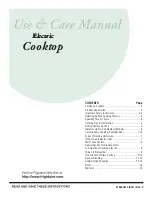
USE OF THE ELECTRIC OVEN
The first time the oven is used, it may give off acrid smells, caused
by the first heating of isolating panels glue surrounding the oven
(it is necessary to heat up the oven at the maximum
temperature for about 30-40 minutes with closed door).
It is something normal, and in case it will occur, wait for the smoke
to stop before introducing the food into the oven.
The oven is fitted with: a rod shelf for cooking food contained in
oven dishes or placed directly on the rod shelf itself, a drip-tray
for cooking sweets, biscuits, pizzas, etc., or for collecting juices
and fats from food cooked directly on the rod shelf.
Note:
The following tables give the main points for cooking some
of the most important dishes. The cooking times recommended
in these tables are approximate. After a few tries, we are sure that
you will be able to adjust the times to get the results you want.
Conventional cooking table
Fan oven cooking table
Use of the oven
Note: ovens with separate thermostat and commutator.
When the functions are used, place the thermostat knob
between 180 ÷ 200°C as maximum temperature.
The oven is fitted with:
a lower heating element;
an upper heating element;
a circular heating element surrounding the fan.
N.B.:
Always set the temperature on the thermostat knob before
selecting any of the functions.
Oven thermostat knob (fig. 1)
To obtain an oven temperature between 50°C and MAX°C, turn the
knob clockwise.
Oven commutator knob (fig. 2)
Depending on the type of oven, it is possible to select one of the
following functions turning the commutator knob clockwise.
MULTIFUNCTIONAL OVEN
The oven is fitted with:
a lower heating element;
an upper heating element.
It is possible to select the desired temperature into the oven by
turning clockwise the thermostat knob (fig. B) and depending on
the models, one or more functions:
Oven off
Oven light
60 ÷ max
Upper + lower heating element on
Upper heating element on
Lower heating element on
Grill element on + turnspit
NATURAL CONVECTION OVENS
Dish
Temp. °C.
Minutes
Weight kg.
Firs courses
Lasagne
200-220
20-25
0,5
Oven pasta
200-220
25-30
0,5
Creole rice
200-230
20-25
0,5
Pizza
210-230
30-45
0,5
Meat
Roast veal
160-180
65-90
1-1,2
Roast pork
160-170
70-100
1-1,2
Roast ox
170-190
40-60
1-1,2
Roast beef joint
170-180
65-90
1-1,2
Roast fillet beef (rare)
180-190
40-45
1-1,5
Roast lamb
140-160
100-130
1,5
Roast chicken
180
70-90
1-1,2
Roast duck
170-180
100-160
1,5-2
Roast goose
160-180
120-160
3-3,5
Roast turkey
160-170
160-240
5 approx.
Roast rabbit
160-170
80-100
2 approx.
Roast hare
170-180
30-50
2 approx.
Fish
160-180
acc. to weight
Sweets (pastries)
Fruit flan
180-200
40-50
Plain sandwich cake
160-180
35-45
Sponge sandwich cake
200-220
40-45
Sponge cake
200-230
25-35
Currant cake
230-250
30-40
Buns
170-180
40-60
Strûdel
160
25-35
Cream slices
180-200
20-30
Apple fritters
180-200
18-25
Sponge finger pudding
170-180
30-40
Sponge finder biscuits
150-180
50-60
Toasted sandwiches
230-250
7
Bread
200-220
40
Dish
Temp. °C.
Minutes
Fish
180-240
acc. to size
Meat
Roast ox
250
30 per kg.
Roast veal
200-220
30 per kg.
Chicken
200-240
50 about
Duck and goose
220
acc. to weight
Leg of mutton
250
30 per kg.
Roast pork
250
60 per kg.
Soufflets
200
60 per kg.
Sweets (pastries)
Tea-cake
160
50-60
Sponge finger
160
30-50
Shortcrust pastry
200
15
Puff pastry
250
15
Fruit flan
200-220
30
Meringues
100
60
Quiches, etc.
220
30
4 quarters
120-140
60
Buns
160-180
45
Note:
All the functions mentioned above switch the oven internal light on.
A warning light on the control panel will stay lit until the temperature
is reached; after it will light up intermittently. Always use the oven with
the oven door closed
Fig. A1
Fig. B
max
60
90
130
170
200
32
75
50
100
125
150
175
200
225
max




































